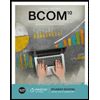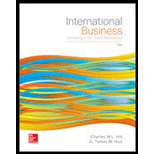
Case summary:
The case deals with the success of Company G in Country C. In 1997, Company G entered to Country C through a joint venture with Company S. Company G introduced additional models in 2007, as they thought that Country C is an important market. Company G believed that their overall success would reflect their decision of building cars as per the need of customers.
Even during the recent recession period, the auto market in Country C was strong. In recent times, Company G sells more cars in Country C when compared to Country U. A recent research predicted that the demand will grow to reach 35 million vehicles per year by 2022.
To determine: The benefits and risks associated with approaching a market through joint venture
Want to see the full answer?
Check out a sample textbook solution
Chapter 15 Solutions
International Business: Competing in the Global Marketplace
- As of July 1, 2022, the investee had assets with a book value of $3 million and liabilities of $74,400. At the time, Carter held equipment appraised at $364,000 more than book value; it was considered to have a seven-year remaining life with no salvage value. Carter also held a copyright with a five-year remaining life on its books that was undervalued by $972,000. Any remaining excess cost was attributable to an indefinite-lived trademark. Depreciation and amortization are computed using the straight-line method. Burrough applies the equity method for its investment in Carter. Carter's policy is to declare and pay a $1 per share cash dividend every April 1 and October 1. Carter's income, earned evenly throughout each year, was $598,000 in 2022, $639,600 in 2023, and $692,400 in 2024. In addition, Burrough sold inventory costing $91,200 to Carter for $152,000 during 2023. Carter resold $92,000 of this inventory during 2023 and the remaining $60,000 during 2024. Required: a. Determine…arrow_forwardFinancial Accountingarrow_forwardA company has an annual demand for.... please answer the financial accounting questionarrow_forward
- On July 1, 2022, Burrough Company acquired 88,000 of the outstanding shares of Carter Company for $13 per share. This acquisition gave Burrough a 25 percent ownership of Carter and allowed Burrough to significantly influence the investee's decisions. As of July 1, 2022, the investee had assets with a book value of $3 million and liabilities of $74,400. At the time, Carter held equipment appraised at $364,000 more than book value; it was considered to have a seven-year remaining life with no salvage value. Carter also held a copyright with a five-year remaining life on its books that was undervalued by $972,000. Any remaining excess cost was attributable to an indefinite-lived trademark. Depreciation and amortization are computed using the straight-line method. Burrough applies the equity method for its investment in Carter. Carter's policy is to declare and pay a $1 per share cash dividend every April 1 and October 1. Carter's income, earned evenly throughout each year, was $598,000 in…arrow_forwardCompute the materials variances on these financial accounting questionarrow_forwardSolve this general accounting questionarrow_forward
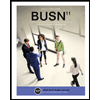 BUSN 11 Introduction to Business Student EditionBusinessISBN:9781337407137Author:KellyPublisher:Cengage Learning
BUSN 11 Introduction to Business Student EditionBusinessISBN:9781337407137Author:KellyPublisher:Cengage Learning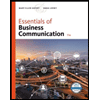 Essentials of Business Communication (MindTap Cou...BusinessISBN:9781337386494Author:Mary Ellen Guffey, Dana LoewyPublisher:Cengage Learning
Essentials of Business Communication (MindTap Cou...BusinessISBN:9781337386494Author:Mary Ellen Guffey, Dana LoewyPublisher:Cengage Learning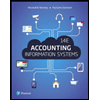 Accounting Information Systems (14th Edition)BusinessISBN:9780134474021Author:Marshall B. Romney, Paul J. SteinbartPublisher:PEARSON
Accounting Information Systems (14th Edition)BusinessISBN:9780134474021Author:Marshall B. Romney, Paul J. SteinbartPublisher:PEARSON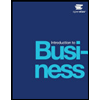
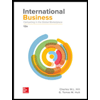 International Business: Competing in the Global M...BusinessISBN:9781259929441Author:Charles W. L. Hill Dr, G. Tomas M. HultPublisher:McGraw-Hill Education
International Business: Competing in the Global M...BusinessISBN:9781259929441Author:Charles W. L. Hill Dr, G. Tomas M. HultPublisher:McGraw-Hill Education